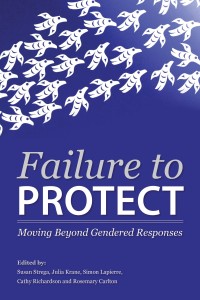Review in Social Work Education: The International Journal

Failure to Protect
Moving Beyond Gendered Responses
Much has been written about current child protection policies and practices in English-dominant states and the authors build on this literature. Drawing from feminist and decolonising frameworks, the book offers a unique perspective in its core theme: current approaches to child protection assume that mothers should and can protect their children from all forms of harm. The authors problematise these practices wherein mothers, rather than the ‘abusers’, are constructed as ‘bad’ and are held accountable for ‘failing to protect’ their children from abuse. Overall, this book makes a strong contribution to critical understandings of child protection. It advances previous works that have discussed the subject from a gendered (e.g. Scourfield, 2003) and/or anti-racist/anti-colonial (e.g. Strega & Carriere, 2009) lens. It also goes beyond other works that have compared services between jurisdictions in one state (e.g. Stafford, Parton, Vincent, & Smith, 2011), by presenting comparisons among states, notably Australia, Canada, the United Kingdom and the United States.
The book is organised as a series of chapters that focus mostly on child sexual abuse and children witnessing domestic violence, highlighting these as two areas where women, as mothers, often seem to be held accountable for failing to protect their children from the harm of another. In each chapter, the authors provide an overview of the topic and show its connection to the book’s main theme. Several chapters provide illustrative examples of policies and practices from the four countries. All chapters are very well referenced. At times, the chapters are repetitive, both within themselves and in relation to other chapters, with the notable exception of the last two, which focus on child protection with Indigenous families. Nevertheless, this repetition is likely deliberate in an effort to reinforce the book’s premise about how mothers are consistently held to account by child protection services when their children are harmed or abused by another, such as their partner. This premise is a key contribution to unpacking the patriarchal practices of child protection, with powerful examples from practice narratives and policy documentation. In the chapters discussing child sexual abuse, the contributing authors suggest that child protection services have a homogenised understanding of how mothers ‘should’ react to their child’s abuse and support the child; the authors posit that these expected responses deny the challenges that many women face in such circumstances, even more so if they are poor or racialised women. The chapters discussing domestic violence examine how current child protection services are inattentive to structural issues that impact the decisions and actions of women in response to abuse. In many chapters, the authors identify the need for a shift in the current prescribed approaches to child protection investigations, arguing for a more narrative approach and attending to the broader issues of family life, including the complexity and dynamic social relations of family members. The book’s overall argument is that the current ideology of holding mothers fully accountable for their children’s well being may actually be putting children at greater risk of harm, suggesting that a more fluid and contextualised approach may be more protective of children by also attending to the needs of mothers. One difficulty in this book lies in its occasional contradictory reasoning. Although several chapters are exemplary in their deconstruction of the research from selected national studies, such explorations sometimes offer an incomplete logic. For example, in questioning the causal relationship between harm to a child through exposure to violence, the authors seem to vacillate between absolving parents of responsibility for their children’s well being while arguing against the current practice of abusers not being held accountable for their actions. This incompleteness may be the result of the need to keep chapters brief, but here and elsewhere the book sometimes makes conclusions without fully establishing supporting arguments. In this way, the book may be best suited for graduate students or as training material for workers currently in the field, where prior knowledge about child protection can close the gaps in some chapters. Though not explicitly naming their approach as anti-oppressive, the authors bring a strong anti-oppressive framework to their analysis. While a broader understanding of intersectionalities and the fluidity of identity construction is missing, the deliberate focus on the intersection of gender and power, often integrated with understandings of racism and especially colonialism, fits well with current scholarship regarding anti- oppressive practice in child protection. This book is relevant to social work education. It offers a unique approach by deconstructing current child protection policies and practices that hold mothers accountable for the harmful actions of others towards their children. Each chapter provides recommendations for changes to policies and practices, with suggestions that could be implemented by individual social workers and students in their placements– and thus is both relevant and practical. - Susan Preston, Ryerson University for Social Work Education: The International Journal, 33:1, 136-138, DOI: 10.1080/02615479.2013.824635

